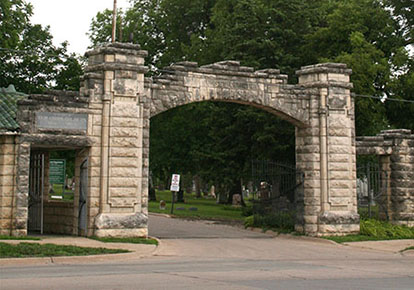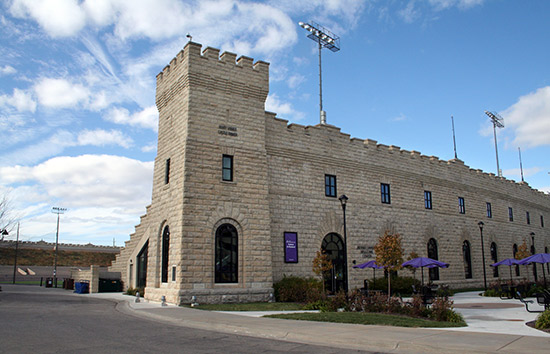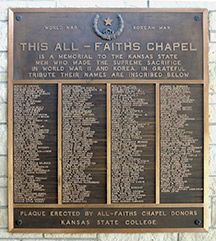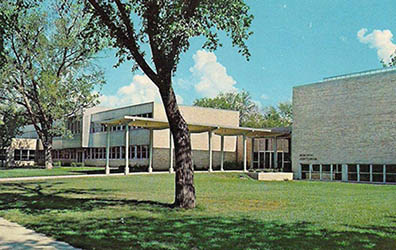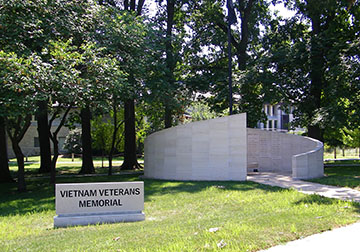Veteran Memorials of Riley County
Since Manhattan was founded in 1855, our community doesn’t have any substantial memorials earlier than the Civil War. There are commemorative white crosses in Sunset Cemetery in honor of the Revolutionary War, the War of 1812, and the Mexican War, but they were later additions and not constructed at the time of these conflicts, and are not substantial memorials.
Manhattan’s first substantial memorials are for the Civil War. As a society, we buried our dead and marked their graves with headstones and monuments, and so the notion of a monument to honor those killed in battle was a familiar thing to do. Memorial artists relied on traditions of funeral art in the 18th and 19th Centuries for inspiration. Memorials prior to the Civil War typically glorified the war leaders (general, colonel, militia leader, etc.), and memorials after the Civil War followed this same pattern, but added tributes to the common soldier.
With World War I, our society starts to shift in its view of memorials towards creating a “living” memorial that has a use and serves the community. The first notion of a “living” memorial dates back to the Reconstruction period following the Civil War, so “living” memorials had started to become topics of conversation years before the idea started to really take off following World War I. Changing attitudes about death also contributed to the interest in “living” memorials. In Puritan times, people dwelled on the horrors of death and hell. The Victorians, however, viewed death as “sweet glory” and “salvation,” and as more associated with a new life. A “living” memorial might have been a way to soften the tragedy and focus less on death.
Sunset Cemetery gate:
The construction of the Sunset Cemetery gate may be an example of a transitional type of memorial. The cemetery gate is in honor of Union soldiers and was erected in 1917, which was about the time that our culture was shifting in its views of memorials. On the one hand, the gate is a traditional memorial arch type of memorial, and as such, was a common type of traditional memorial, but on the other, the gate also serves a function in marking the entrance to the cemetery and is not just a decorative arch in a park or public square. The gate also includes a shelter/pavilion or “rest room” on the south side, which includes built-in benches and was intended to be a space where a funeral procession could gather, a mourner could rest in the shade, etc., meaning the space has a purpose. In the arch, we see a blend of both the traditional memorial and the useful "living" memorial.
The first serious criticisms of traditional memorials began as soon as World War I ended in Nov. 1918. The traditional monument or statue was viewed as vulgar, cluttering the landscape, and not an adequate tribute to those who had been killed. They weren’t artistic or inspirational. Monuments of marble and bronze seemed to be monuments of waste and indulgence.
In 1920, the Municipal Art Society of New York City issued a booklet on war memorials and expressed fear of a return to the “dismal stone age” of Civil War type of memorials, and expressed a preference for memorials that were practical. The general sentiment was that it was better to honor the dead with things that were of benefit to society, to invest in institutions that represented the ideals for which the soldiers had fought and died. “Living” memorials were viewed as celebrating democracy, community, and the pursuit of “better living.”
The idea of a “living” memorial following World War I took off and spread across the nation, and along with it the notion that memorials needed to take on a new form. The practical “living” memorial was less associated with death, and deflected death into leisure in the form of a community park, bridge, recreational facility. Communities tended to select as the object of the “living” memorial something they needed – hospital, library, bridge, swimming pool, sports stadium, and the most popular after World War II was the public auditorium.
There was a company that mass-produced doughboy sculptures, and many communities purchased them for their World War I memorial, so traditional memorials weren’t entirely displaced, but in communities with the financial means to construct something grander, “living” memorials were popular. Many times even if a community had constructed a “living” memorial, they also had a plaque, an honor roll, or something along the lines of a traditional memorial that also helped to explain who the “living” memorial was honoring.
Community House:
In Manhattan, the Community House is an “after-the-fact” “living” memorial. “After-the-fact” because it wasn’t built with that purpose in mind, but was “permanently dedicated to the soldiers of that war” in 1941 (meaning World War l), and it serves our community and can be thought of as a “living” memorial. The Community House was built during 1917-18 during World War I as a recreation center for soldiers – a place for them to sleep and be entertained – a precursor to the U.S.O. During World War II, the Community House was used again as a U.S.O. In between the wars, the Community House was used by the American Legion and the Chamber of Commerce. Today, Parks and Rec. uses the Community House for its programs.
Memorial Stadium:
Manhattan’s first official “living” memorial is Memorial Stadium on the Kansas State University campus, which is a memorial to the students and faculty who were killed in World War I. The effects of the war were acutely felt on campus, where many male students left their studies to enlist or were allowed to graduate early, and many faculty members also enlisted. In total, more than 1,200 students and faculty served, and 48 were killed in the war. Following the war, KSAC wanted to establish a “worthy memorial to our soldier dead.” The first suggestion was to build a student union, but with an estimated cost of $250,000, the student union idea never took off. KSAC needed better athletic facilities, and it didn’t take long for a planning committee to come up with a sports stadium as a second idea, noting that a stadium “will be a structure of beauty and dignity” as well as “useful.” Many other colleges also constructed memorial stadiums, including the University of Kansas. To pay for Memorial Stadium, faculty members were asked to contribute 2.6% of their annual salary, and students were asked to contribute $40, payable over 4 years. Many local citizens and businesses also donated to the construction costs. The west side was completed in 1922, and the east side was completed in 1924. Identical plaques with the names of the 48 who were killed are displayed on both sides of the stadium. The west and east sides were enclosed in the 1930s with funding coming from the Works Progress Administration.
The arc of the horseshoe was never completed [the original plans were a horseshoe shape for the stadium], which was going to be the main entrance and where the World War I memorial wall was going to be displayed [it's a beautiful floor-to-ceiling wood piece with a photograph of each of the 48 who were killed]. Instead, it was housed in Anderson Hall for many years, covered by a curtain because people didn’t like looking at photographs of the dead. During an Anderson Hall remodel, the memorial wall was moved to under the stadium near the police station where it was left to rot for many years, until one day, an ROTC student discovered it. The memorial wall was then moved to the basement of Myers Hall around 2000-02, and needed over a year of restoration work to repair damage. And today, the memorial wall is in Myers Hall.
Danforth and All Faiths Chapels:
Danforth Chapel and All Faiths Chapel on the K-State campus are another example of “living” memorials. After the end of World War II, a fund was started among alumni to raise money to construct a suitable memorial to the men and women who had served. The money was raised, and Dwight Eisenhower turned over the first shovel of dirt in 1949 to build Danforth Chapel. All Faiths was originally intended to be the same Gothic style as Danforth, but the Korean conflict started, and all construction was shut down so materials could be dedicated to the war effort, and in the meanwhile, the Gothic plans were abandoned in favor of a contemporary and functional style, with a foyer and 470-seat auditorium. All Faiths Chapel was dedicated in the spring of 1956. Danforth and All Faiths Chapels are dedicated to the more than 200 students who died in World War II and the Korean conflict. A large bronze plaque in the lobby area lists the names of K-State students who died in World War II or Korea.
(Danforth Chapel was built in 1949 with funds donated by Mr. and Mrs. William Danforth. Other universities also have “Danforth Chapels” financed by the Danforth family, including the University of Kansas.)
The “living” memorial movement was still going strong after World War II, and commemoration and leisure had become even more intertwined. The spirit of the homefront of everyone working together continued on with working together to build a “living” memorial for the community to use.
Peace Memorial Auditorium:
Following World War II, the citizens of Manhattan set out to build a “living” memorial to honor the 2,610 Riley Countians who had served and the 101 servicemen who lost their lives in the war. In 1946, citizens approved an $800,000 bond to build a memorial auditorium. City offices and a fire station were later additions to the project. The building was completed in 1955. Newspaper accounts and other sources, such as the American Legion newsletter, make it clear that citizens intended the auditorium to be a World War II “living” memorial. High post-war building prices caused the start of construction to be delayed, the 1951 flood was also a factor, and there was also uncertainty as to where to place the auditorium, with some favoring City Park and others firmly against that idea. At one point, the school district was going to tear down Woodrow Wilson because the school board thought it had been built too close to Bluemont, and the auditorium could be built on Wilson's lot. But it wasn't long before the post-war baby boom hit the school district, and not only was Wilson needed, but the school district asked voters to approve a bond for a new elementary (Lee). The auditorium was dedicated on Sept. 26, 1955, which was also Manhattan’s centennial year, and likely explains why early settlers are mentioned on the dedication plaque. Why World War II isn't specifically mentioned on the dedication plaque is unknown. Possibly the 9 years between the bond and construction completion had made citizens fuzzy on the original intent. Possibly the Korean conflict had had an impact, as it had with Danforth and All Faiths, and citizens didn't want the dedication language to exclude Korean veterans, but the true reasons are unknown.
There actually is a plaque with the names of the 2,610 Riley Countians who served, the 101 who were killed, and 82 who were wounded, that was created during the war. It’s a very large plaque, 12 feet by 4-5 feet high. For many years, it hung next to the World War I plaque in the Riley County Courthouse. It’s in somewhat delicate condition, so at present, it’s carefully housed in storage at the Riley County Historical Museum where it’s stored in the dark and in a temperature and humidity controlled environment, and clothing items are stored in front of it, which also helps to protect it. Newspaper articles post World War II show that originally the plan was to place this plaque in the auditorium once the auditorium was completed, and a later article said the plaque was going to be moved to the Courthouse.
Throughout the “living” memorial movement, there were opponents to the idea. Critics thought that a “memorial swimming pool” didn’t bind people to the dead and stir feelings of remembrance and motivations to maintain peace. The idea that soldiers had given their lives for a memorial bridge didn’t seem important and somber enough. Without something that symbolizes the memorial to the dead, the place will become purely functional and cease to be a reminder of those it’s meant to honor. And one of the main reasons for opposing “living” memorials is changes to the landscape. Bridges, swimming pools, hospitals will age. Community needs will change, and city planners might want to demolish a memorial building sometime in the future, and so then what happens to the memorial?
In 1982, the Vietnam Memorial Wall opened on the National Mall, and with the selection of this design -- a large piece of black granite -- its choice influenced other memorial design choices across the country, seemingly marking a cultural shift to remembering wars once again with a traditional monument.
Another World War II memorial is on the K-State campus, and although it commemorates World War II and a time when “living” memorials were popular, the memorial was not constructed until 2011, and by then our society had shifted again to the more traditional idea of memorials. The design is intended to be more of a sculpture, a piece of art, than simply a monument.
In 1986, K-State students launched a campaign to raise $22,000 to construct the Vietnam Memorial, which was constructed in 1989. As with the World War II memorial on campus, it was constructed post 1982 and reflects a return to the traditional memorial. It features two curved walls with the names of the 42 students who were killed or are listed as “missing in action.”
In recent years, the idea of a “living” memorial seems to literally mean "living" in the form of planting a rose bush, a tree, or a memorial garden to commemorate the loved one. The William Grimm memorial on campus is an example of the modern interpretation of a “living” memorial. Captain Grimm is the only K-State student killed in Desert Storm, and his memorial is the only local Desert Storm memorial, and it evokes the idea of the modern “living” memorial with the planting of an oak tree.
Another type of modern "living" memorial is the “celebration of life” type of funeral that features photos of the deceased in a PowerPoint accompanied by the deceased's favorite music -- all of the happy, positive memories from the deceased's life.
Creating a memorial to Dwight Eisenhower has also put “living” memorials back in the news. Instead of creating a monument, Eisenhower family members had expressed their preference of creating a “living” memorial in the form of a foundation whose work would reflect Eisenhower’s ideals.
And so today, our culture has shifted back to designing traditional monuments and markers for memorials, and also seems to still be defining what it means to be a "living" memorial.

